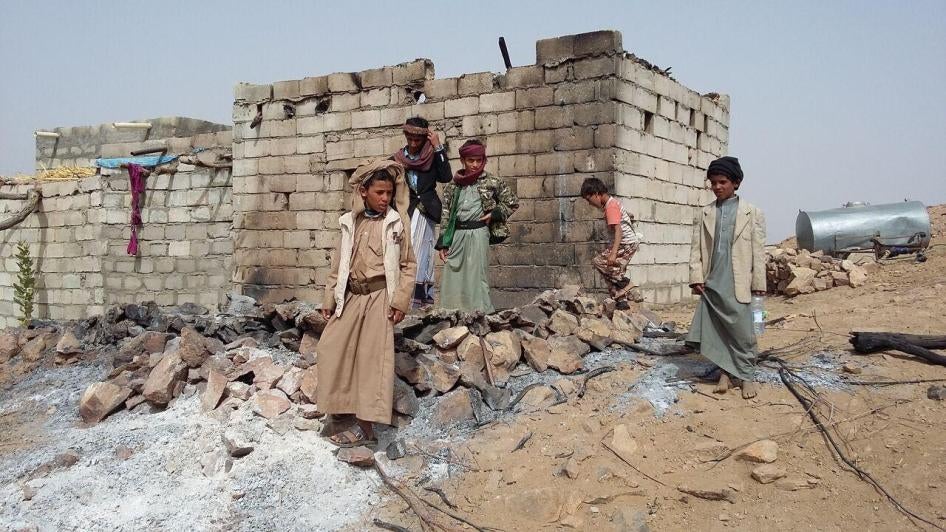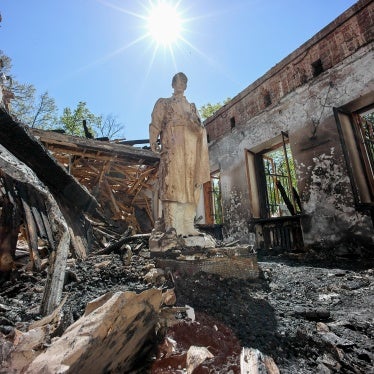(Washington, DC) – The US government should credibly investigate the raid on Al-Qaeda in the Arabian Peninsula (AQAP) in central Yemen in late January 2017, that killed at least 14 civilians, including nine children, and make its findings public, Human Rights Watch said today.
The high number of civilian casualties raises concerns that US forces and the armed group failed to take all necessary measures to minimize loss of civilian life, as required by the laws of war. The US government reported that 14 AQAP fighters and a US service member were killed in the fighting and, three days after the attack, that civilians, including children, were
likely killed.
“The US military’s acknowledgment of civilian deaths in this attack was a rare departure from past US practice in Yemen, but it’s not enough,” said
Nadim Houry, terrorism and counterterrorism director at Human Rights Watch. “The US needs to go a step further and provide a full accounting of possible laws-of-war violations and deliver appropriate compensation to civilians.”
On January 29, 2017, US special forces were inserted by aircraft and
conducted a raid in al-Ghyeel, a small village in the Yakla area of the central Yemeni governorate of al-Bayda, about 145 kilometers from Aden, Yemen’s southern port city. The raid, the first of its kind by US forces in Yemen in over two years, was aimed at “
intelligence-gathering,” the US military said.
Human Rights Watch spoke about the attack with several village residents and the director of a hospital that treated three of the wounded. Witnesses said that five women and nine children were among the civilians killed in the raid.
Witnesses said that at about 2 a.m., about 30 US personnel flanked by military dogs approached the home of a military commander, Abdul-Raouf al-Dahab. Men in al-Dahab’s house heard people approaching and called out. When they got no response, they began shooting, one witness said. Those outside returned the gunfire. Another witness, who was in the house next to al-Dahab’s, said that the men in the house fired warning shots into the air and that the forces outside then opened fire on the home.
The US military said that its
forces came under heavy fire “from all sides,” including from “houses and other buildings” and from “armed women firing from prepared fighting positions.” While Human Rights Watch could not confirm that account, civilians who directly participate in hostilities are subject to attack under the laws of war.
The gunfire quickly escalated, with the villagers engaging in a firefight with the forces outside, witnesses said. As the fighting intensified, helicopters and other aircraft began firing on the village with light automatic cannons. Witnesses said that at least 20 houses were damaged.
Witnesses said that US ground forces and aircraft appeared to target anything that moved and anyone who left their home. Aziz al-Ameri, a member of the local governing council, said that he and his family woke up when they heard gunshots. They initially thought it was a tribal or personal dispute: “We were surprised when we saw the [attack helicopters] coming and surrounding the whole village. … They were shooting at anything moving, anything that moved they shot, human or animal, even donkeys.”
“The women who have been killed, some of them were carrying their children, some running away,” al-Ameri said. “They raided our houses, destroyed them, killed our women and children.” He said that Fatim al-Ameri, a mother in her mid-thirties who is a relative of his, was found dead, with her 2-year-old son in her arms. The boy survived. Another boy, 5, was found dead next to the door of his house.
Local activists said that many of those wounded were not able to get medical care, as the village is remote. Dr. Ameen Mabrook, director of the “26th September” hospital in al-Joubah district in Marib, a five-hour drive from the Yakla area and the nearest hospital that provides neonatal care, said that the hospital received three people wounded in the raid – a young man shot in the leg, a pregnant woman, and a small girl. The woman, who was nine months pregnant, had been shot in the stomach. The hospital performed an emergency caesarean section, but the baby died.
Col. John J. Thomas, spokesman for the US military’s Central Command (CENTCOM), blamed AQAP for the civilian casualties. He told the media that AQAP has “
a horrifying history of hiding women and children within militant operating areas and terrorist camps… That’s what makes cases like [the al-Bayda raid] so especially tragic.”
Yakla residents disputed claims that the most of those killed in the fighting were AQAP members. The residents said that the village consists of a cluster of houses, next to two other small villages, with about 200 houses and 1,000 residents in all. Most of those killed lived in al-Dahab’s house, which US forces approached first, and in the two homes next to it, which belonged to Abdullah al-Ameri and his son Muhammad.
The US included Abdel Raouf al-Dahab and his brother Sultan as among the AQAP fighters killed in the raid, but residents denied that either brother was with AQAP. Instead, two residents said that Abdel Raouf al-Dahab was working with the Yemeni army fighting Houthi-Saleh forces and had returned to the village to distribute salaries to non-AQAP fighters backing President Abdu Rabu Mansour
Hadi. The
Associated Press, which interviewed tribal leaders, military officials, and al-Dahab’s relatives, found that al-Dahab was commanding a force of tribal fighters, but probably was not with AQAP.
One source said that Muhammad al-Ameri was an AQAP member, and that he hosted AQAP members in his home, including at the time of the attack. Witnesses said that al-Ameri’s house was destroyed by an aerial bomb soon after fighting began, killing at least nine people, including him, four women, and four children.
Arwa al-Baghdadi, a Saudi woman killed in the raid, had fled to Yemen in 2013 after being
imprisoned in Saudi Arabia and reportedly joined AQAP. She was living with some of her relatives near al-Ameri’s house, a source said.
AQAP released two statements on the raid, extolling the men in Yakla for fighting the US forces. In the second statement, a few days after the raid, AQAP’s leader in Yemen, Qassim al-Raimi, expressed condolences to the community, listing 14 men, two women, nine children, and other members of a family as among those killed. He did not clearly state that the 14 men were AQAP members, but eight were listed with a
nom de guerre, indicating likely membership. Al-Raimi also expressed special condolences to the al-Dahab family and for the deaths of al-Baghdadi, her son, and her brother to her husband, who is in jail in Saudi Arabia.
Human Rights Watch collected 23 names and ages of villagers killed in the raid. A witness said that two other people died but he could not remember their names. The Bureau of Investigative Journalism, which worked with a Yemeni journalist who visited the Yakla area less than a week after the raid,
collected 25 names and ages of those who died from Yakla’s residents, which matched the names Human Rights Watch collected.
After the raid, photos of the children who died circulated on the internet and in local media. One photo showed 8-year-old Nawar al-Awlaki, who a relative said was fatally struck in the neck by a bullet. Her father, Anwar al-Awlaki, an imam, was the target of a lethal
US drone strike in 2011 because of his alleged activities for AQAP. Her 16-year-old brother, Abdulrahman, had been killed in a
drone strike two weeks later that the US said targeted a senior AQAP operative.
Three days after the raid, on February 1, 2017, CENTCOM announced that it
was conducting a “credibility assessment” into civilian casualties. It did not say whether the results would be made public, or whether any civilians harmed or their families would receive compensation.
Sheikh Abdulelah al-Dahab, who lost two brothers, Sultan and Abdel Raouf, a 12-year-old son, and a 13-year-old nephew, Nasser, in the attack, said:
Civilians got killed here. Fighters… were defending their homes. … Nine kids got killed. We don’t want any compensation. We want justice and the perpetrators to be held to account. We want to know what our government’s position is on what happened.
Nasser’s father, Abdullah, said that his son had gone to visit family members in the Yakla area during the midterm school holiday:
Nasser was very smart, and he was special to me. He was my friend, despite being young, and I trusted his decisions. … The American raid killed my son, a student in the eighth grade. … There needs to be accountability for those who carried out this crime before American courts.
The raid followed an increase in US military operations against AQAP in 2016, when the US conducted at least 33 drone strikes against alleged AQAP targets and deployed a small number of special operations forces to Yemen to assist the United Arab Emirates’ (UAE) efforts against the armed group. The UAE has provided training, funding, and direction to Yemeni security forces that are carrying out operations against AQAP, and, the New York Times reported, provided support for the al-Bayda raid.








